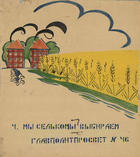The Russian Revolution opened up new windows on art
“Henceforward, Art will no longer live in … palaces, galleries, salons, libraries, and theatres. The Free Word will henceforth be painted on the street corners, houses, fences, roofs of our towns and villages. From house to house, let streets and squares be ablaze with colour and images.”
Vladimir Mayakovsky was one of the signatories to the manifesto of the Futurists (in Gazeta Futuristov, 15 March 1918). Before long, he was able to transform ideas into practice when, a year later, he started to work for ROSTA, a press agency established in September 1918 to disseminate information from the Bolshevik authorities to the people.
As Mayakovsky (1893-1930) excelled in both literary and graphic art, he worked on the Okna ROSTA poster project, a series of posters designed to convey messages in simple terms to the virtually illiterate public. Okna means “windows”. The posters were to be displayed in shop or kiosk windows so they could be seen by passers-by.
Mayakovsky drew the cartoons in a template on cardboard; sometimes his muse Lili Brik did the colouring. They were then reproduced using a sort of stencil machine in a print run of 150 copies.
The IISH has ten original ROSTA posters designed by Mayakovsky, and a number of reprints.











